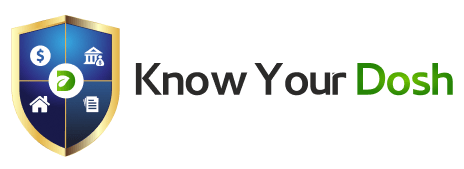Summary:
• Family Collaboration: Know Your Dosh provides individual secure logins for each family member, while Quicken requires sharing passwords for family access
• Multi-User Design: Purpose-built for families with customisable permissions vs. 40-year-old individual software with sharing workarounds
• Financial Education: Children can safely access age-appropriate financial information and learn money management through real family data

Here’s the thing about Quicken… it’s been around since 1983. Ronald Reagan was president. The internet didn’t exist. Families managed money with check-books and filing cabinets.
Fast forward to 2025: The Johnson family includes two working parents, a teenager saving for university, and grandparents helping with education costs. They need financial software that lets everyone participate safely and appropriately.
Quicken doesn’t.
Not because it’s bad software, it’s actually quite good at what it was designed to do forty years ago. The problem is that “what it was designed to do” assumes you’re a single person managing money with no need for family collaboration, shared goals, or multi-generational coordination.
Modern families broke that model years ago.
The “Share Your Password” Security Nightmare
Here’s how family collaboration works in Quicken: you give your family members your password.
That’s it. That’s the solution.
Your teenager wants to check their college fund progress? Share your password. Your spouse needs to update expenses while you’re at work? Share your password. Want to include grandparents in family financial planning? You guessed it… share your password.
This isn’t 1983. Sharing login credentials is basic security malpractice that puts your entire financial picture at risk. Yet it’s the only way Quicken enables family access because the software was never designed for multiple users.
Know Your Dosh gives every family member their own secure login with customisable permissions. Parents maintain overall control while spouses collaborate as equals and children access age-appropriate information. No security compromises. No shared credentials. No hoping your teenager doesn’t accidentally delete something important.
What Quicken Gets Right (And Why It’s Not Enough for Families)
Credit where it’s due, Quicken dominates individual financial management for good reasons:
Investment tracking is comprehensive. If you’re managing a complex portfolio as an individual investor, Quicken’s analysis tools are excellent.
Tax integration works seamlessly. For tax preparation, Quicken connects directly with tax software and provides detailed reports.
Business features are solid. If you’re a small business owner managing both personal and business finances, Quicken’s business versions offer useful functionality.
Historical data goes deep. Forty years of development means Quicken handles edge cases and provides detailed reporting that newer software might miss.
But here’s the problem: families don’t need individual investment analysis tools. They need collaborative financial management. They don’t need business expense tracking. They need shared family goal tracking. They don’t need 40 years of feature accumulation. They need modern, intuitive design that works for family members with different technical comfort levels.
The Real Cost of Using Individual Software for Family Finances
Families using Quicken don’t just lose features, they develop expensive workarounds:
The Co-ordination Tax: One person becomes the family financial manager by default. Every budget discussion requires that person to be present with their laptop. Every financial decision waits for the Quicken operator to pull reports. Family financial meetings become presentations rather than collaborative planning sessions.
The Education Gap: Children grow up excluded from family financial management. They can’t see college fund progress, don’t understand family financial goals, and miss crucial financial education opportunities during their formative years.
The Security Risk: Shared passwords create vulnerability. When family members can’t access their own financial information securely, families choose convenience over security. The potential cost of a security breach far exceeds any software savings.
The Participation Problem: Family members who can’t access financial information become disengaged from family financial goals. Saving for vacations, education, or major purchases becomes abstract rather than motivating when progress isn’t visible to everyone involved.
How Modern Family Finance Actually Works
Walk into a successful family’s financial planning session in 2025, and here’s what you’ll see:
Dad pulls up the family dashboard on his phone while Mom accesses the same information on her tablet. Their 17-year-old daughter joins the conversation with real-time access to her college savings progress. Everyone can see the family’s vacation fund goal and contribute to budget discussions using the same shared data.
When they discuss whether to increase retirement contributions or boost the kids’ education savings, everyone participates with complete information. When their son calls from university needing money for textbooks, they check the education account together and make an informed decision.
This isn’t possible with Quicken’s architecture. It requires purpose-built family financial software that assumes multiple users, collaborative decision-making, and shared financial responsibility from the ground up.
The Family Collaboration Advantage
Modern families don’t manage money individually, they coordinate as teams. They have:
- Two working parents who both need access to account information
- Teenagers learning financial responsibility through college savings and part-time jobs
- Family goals like vacations, home improvements, or education funding that require shared tracking
- Grandparents contributing to education funds or helping with major purchases
- Emergency situations where multiple family members need quick access to financial information
Quicken’s single-user design creates bottlenecks and excludes family members from participating in their own financial future.
Why We Built Know Your Dosh Differently
When we started developing Know Your Dosh, we could have created another individual finance app with sharing features bolted on. Instead, we asked a different question: “How do successful families actually coordinate their finances?”
The answer wasn’t individual software with workarounds. It was collaborative platforms designed for family participation from day one.
Every feature considers multiple users with different needs. Every interface assumes family collaboration rather than individual control. Every security measure protects family members while enabling appropriate sharing. Every report supports family decisions rather than individual analysis.
The result is software that feels natural for families because it was built for families, not adapted from individual tools.
Practical Scenarios Where the Difference Matters
Scenario 1: Family Emergency
Your teenager calls from university, they need emergency funds for a medical issue. With Quicken, one person checks the budget and makes the decision. With Know Your Dosh, both parents can simultaneously review available funds, check available resources, and coordinate the transfer while keeping their student informed about the process.
Scenario 2: Retirement vs Education Planning
Your family needs to decide between increasing retirement contributions or boosting education savings. With Quicken, one person runs reports and presents options. With Know Your Dosh, both parents can explore scenarios together, see the compound interest impact of different choices, and make informed decisions collaboratively.
Scenario 3: Teaching Financial Responsibility
Your teenager gets their first job and wants to learn money management. With Quicken, you can show them your screen occasionally. With Know Your Dosh, they get age-appropriate access to track their college fund growth, manage their spending categories, and participate in family financial discussions with real data.
Scenario 4: Family Vacation Planning
Your family wants to save for a major vacation. With Quicken, one person tracks progress and reports to others. With Know Your Dosh, everyone can see progress toward the goal, contribute ideas for cutting expenses, and stay motivated by watching the vacation fund grow.
The Geographic Flexibility Bonus
While most families operate within one country, Know Your Dosh’s international capabilities provide valuable flexibility when you need it:
- University abroad: If your child studies internationally, you can track education expenses across different currencies
- Family travel: Extended travel or temporary relocations don’t disrupt your financial management
- Investment diversification: International investment opportunities become easier to track alongside domestic assets
- Extended family: Grandparents or relatives in different countries can participate in family financial planning
These capabilities are available when needed but don’t complicate the experience for families with purely domestic finances.
Making the Decision That’s Right for Your Family
Choosing between Quicken and Know Your Dosh isn’t about which has more features or better reviews. It’s about which aligns with how your family actually manages money.
If you’re a single person or strongly prefer individual control over all household finances, Quicken remains a solid choice. Its depth, maturity, and individual-focused tools serve that use case well.
But if your family includes multiple people who should have financial access, values collaborative financial management, or wants to include children in age-appropriate financial education, Know Your Dosh addresses needs that Quicken simply can’t meet through its current architecture.
The families who thrive financially in 2025 don’t use individual software with workarounds. They use collaborative tools designed for shared financial responsibility, family goal achievement, and multi-generational financial education.
Your family’s financial software should work the way your family actually makes money decisions. If that’s collaboratively, securely, and inclusively, the choice becomes clear.
Ready to experience family financial management built for how families really work? Hundreds of families already made the switch from individual software to collaborative solutions designed specifically for household financial coordination.






